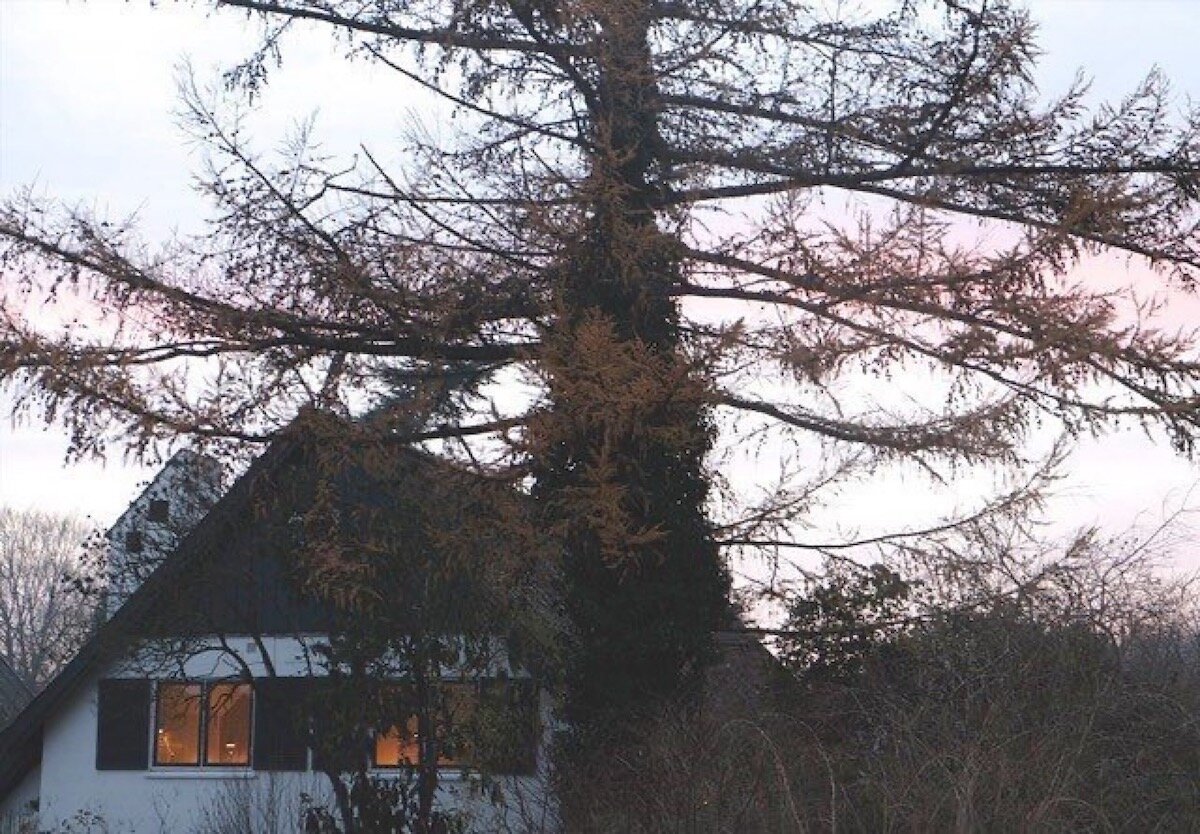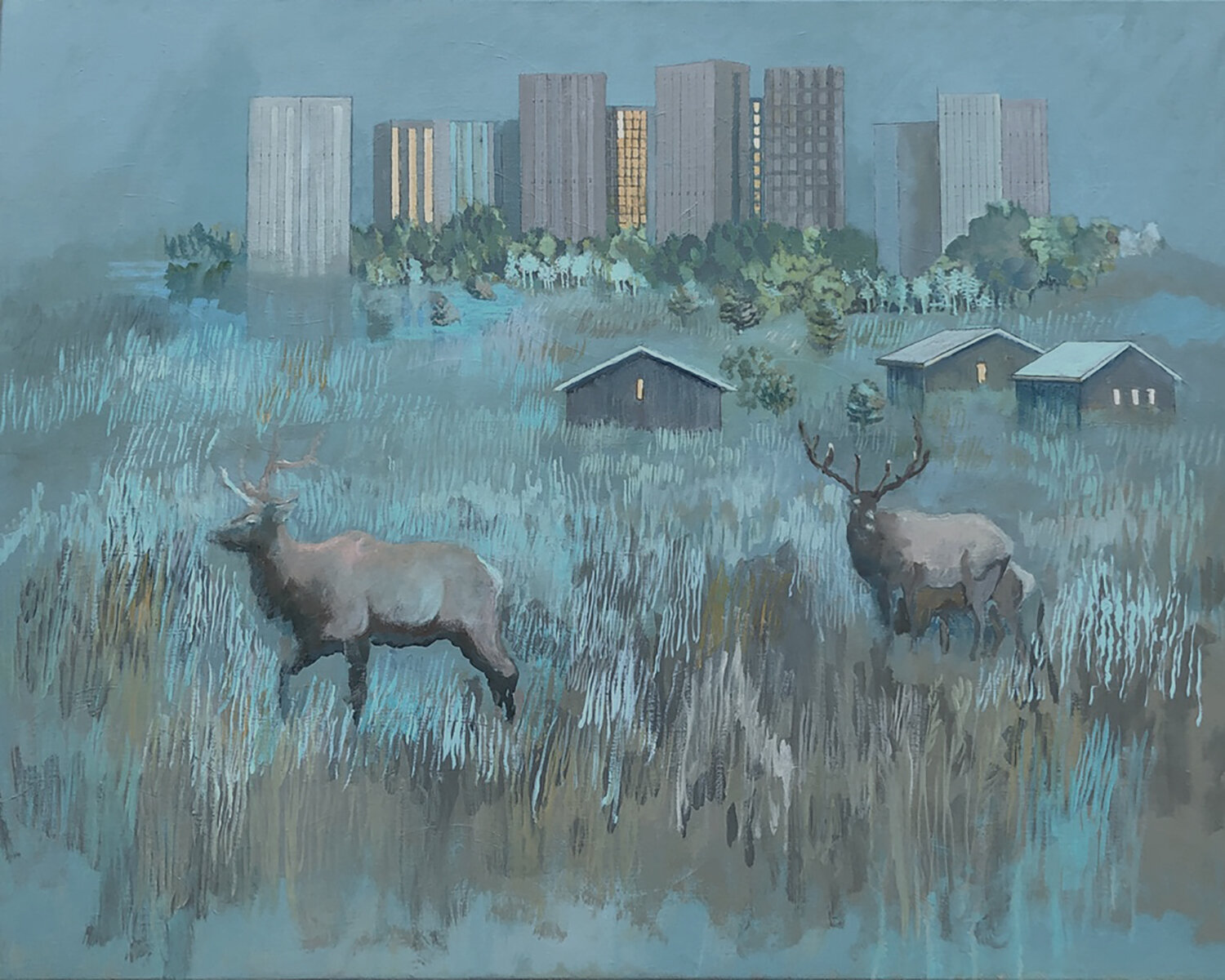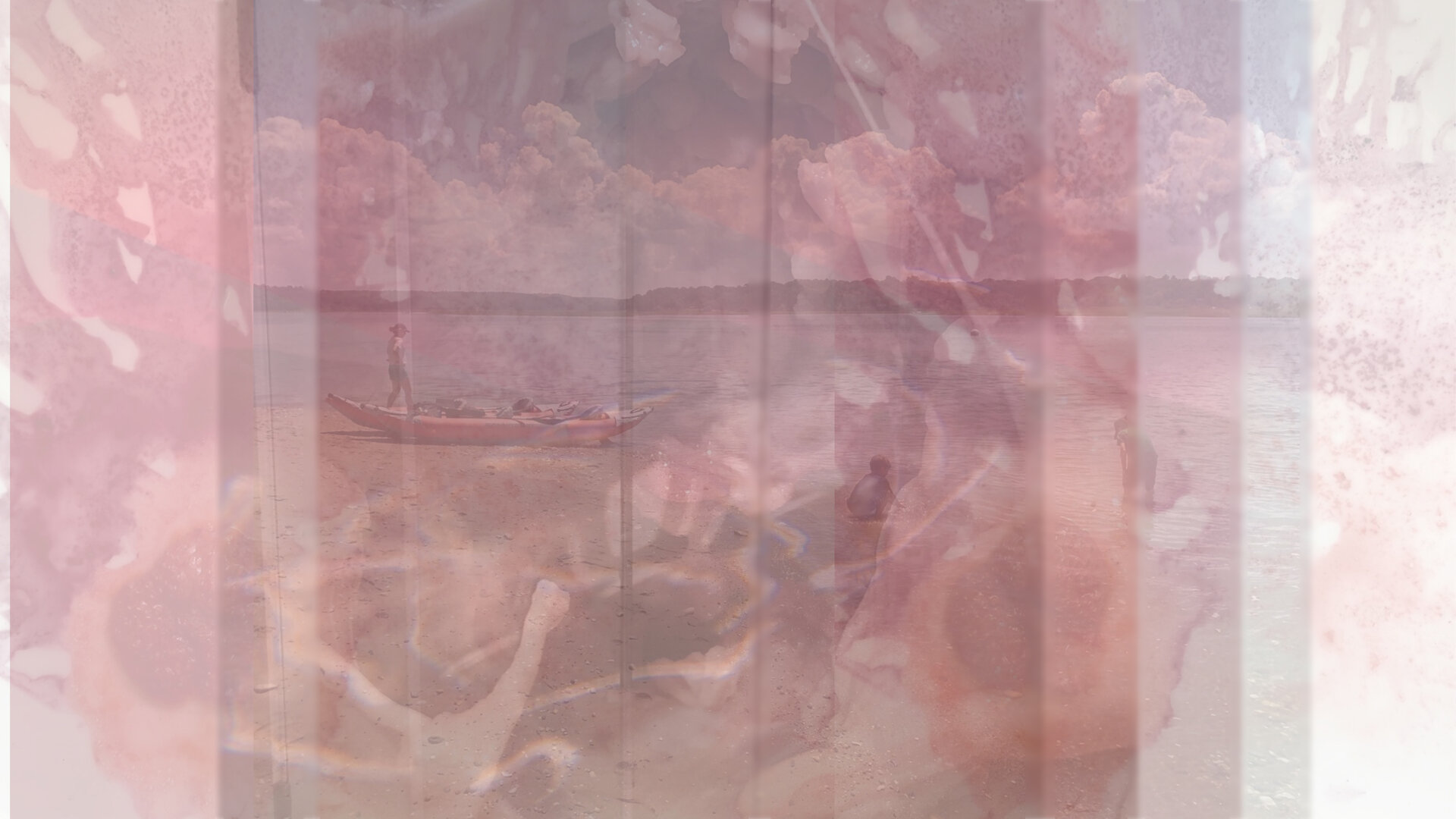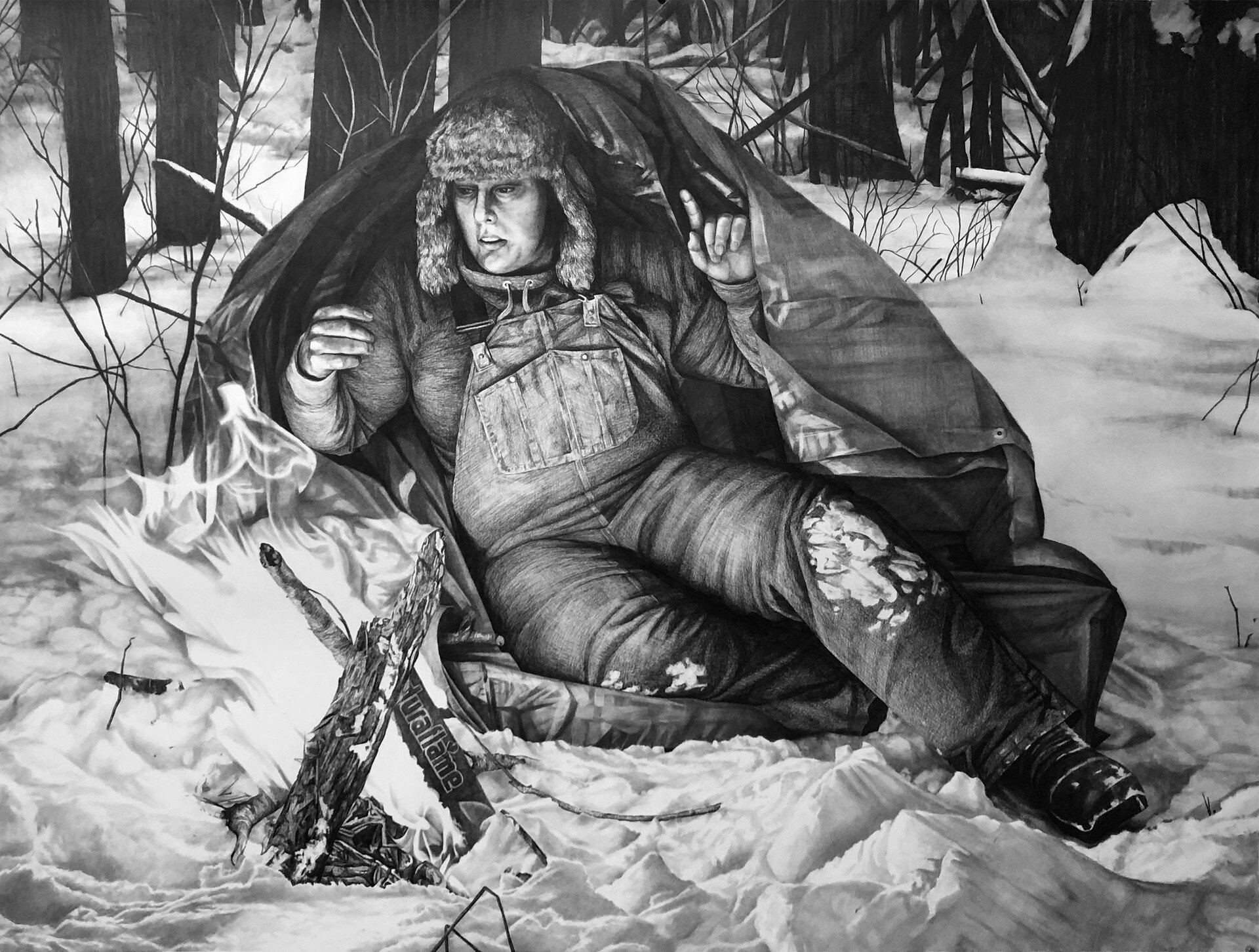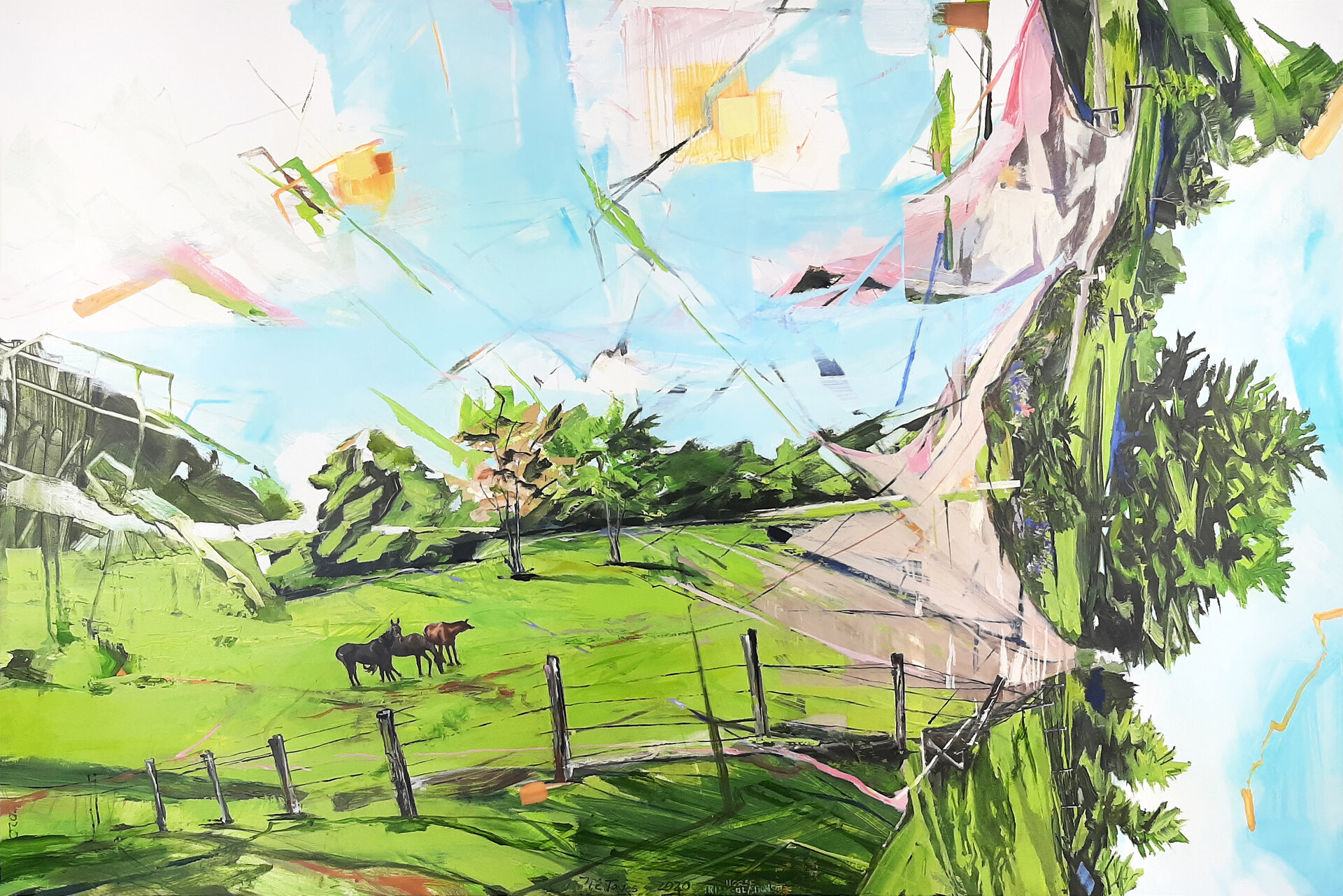Landscape
Exploring The Built And Grown
An Online Exhibition
June 17 – July 27, 2021
Juried by Jennifer McGregor
The confluence of built and grown landscape is represented in this exhibition through fragmentary approaches and processes that reveal the human presence in nature. The works were created over the past two years and convey a sense of urgency or dislocation. The artists’ relationships to nature and their curiosity and willingness to experiment comes through in these paintings, photographs, sculptures and mixed media artworks. The fractured points of view expressed are in keeping with the ruptures caused by the pandemic and a sense of increased environmental urgency.
Wall 1
Bryce Lafferty meshes memory of a place with categorical knowledge of how we try to understand the complexity of the natural world using cross sections and other patterns that humans impose on the landscape to describe it. Nathan Taves’s deconstructed landscape features a bucolic scene of grazing horses but the jumbled perspective obscures the horizon line, suggesting movement through a fractured viewpoint.
James Seffens painting process fragments the industrial landscape. In Seismic Shift, Kellyann Monaghan explores the force of nature rupturing the highway from an aerial perspective that appears vertical, disorienting our point of view. In The 405 Altarpiece Marjorie and Bob Moskowitz combine their individual approaches to landscape and figurative painting, to create a mash-up where farm meets highway, and lack of human control is exposed.
Nathan Taves
Bryce Lafferty
Bryce Lafferty
Eastern Canyon
Watercolor and gouache on paper
30" x 22"
$2,700.00
Nathan Taves
Pasture Cliffs
Oil on panel
24" x 36"
$4,400.00
James Seffens
Kellyann Monaghan
James Seffens
The Tracks
Enamel on Wood
24" x 24" x 1"
$1,400.00
Kellyann Monaghan
Seismic Shift
Oil on panel
36" x 26"
$1,500.00
Marjorie and Bob Moskowitz
Marjorie and Bob Moskowitz
The 405 Alterpiece
Oil
40" x 120" x 2"
$18,500.00
Wall 2
Several artists convey the experience of a place where natural and built collide. In Meridith McNeal’s large-scale watercolor painting, the window reflections accentuate the fragmentation of inside and out that suggests the urban environment that surrounds the viewer. In Humboldt Street by Alex Hutton, the ephemerality of the balloons anchored in treetops evokes a sense of time standing still. Sam Elkind’s Cattle Country uses layers of reflection to place the viewer at a cow crossing in the middle of wide-open terrain. By taking apart and reconfiguring elements of the landscape David Disko accentuates the juxtaposition between sky, land, and the built environment.
Sam Elkind
Sam Elkind
Cattle Country
Photography - archival warm-tone inkjet print
26” x 20”
$500.00
David Disko
David Disko
CHASING SHADOWS
Spray paint and oil on re-purposed canvas
16" x 20" x 1.5"
$600.00
Alex Hutton
Alex Hutton
Humboldt Street
Oil on canvas
48.5" x 42" x 1.5"
$1,400.00
Meridith McNeal
Meridith McNeal
Inside Outside Filaments (Atlantic Avenue, Brooklyn)
Watercolor on paper
75" x 55"
$25,000.00
Wall 3
The COVID-19 pandemic had a bearing on all aspects of life and some artists found new ways to work. Erick Collier’s view from the window is emblematic of the daily views that many people appreciated during quarantine. Meryl Blinder overlays the natural and built environments alluding to the way the pandemic has made us re-think our relationship by spending more time outdoors. Meredith Starr and Dayna Leavitt created a series of layered, composite, dreamlike landscapes through a transatlantic collaboration, the result of an ongoing digital conversation between friends. John Slepian began using Google Earth, an iPhone and Polaroid Lab printer as tools to travel with 21st Century technology to rediscover 19th Century landscape frames, in this case Eadweard Muybridge’s iconic view of Union Point at Yosemite. Lisa di Donato’s imagery in the Ontic Glow series is generated using Google Earth’s 3D to explore industrial sites and remote locations. The collected photos are configured as panorama and printed using the 19th century tintype methods to create a collision of old and new.
Meryl Blinder
Erick Collier
Erick Collier
Bold life
Acrylic paint on paper
6" x 6"
SOLD
Meryl Blinder
Empty City
Oil on canvas
30" x 40" x 2"
$3,200.00
Meredith Starr & Dayna Leavitt
Meredith Starr and Dayna Leavitt
Are You There...It Looks Like You Went To Another World
C-print
9" x 16" x .5"
$500.00
Meredith Starr And Dayna Leavitt
Are You There... We Went A Long Way Today
C-print
9" x 16" x .5"
$500.00
John Slepian
John Slepian
Photos of Google Earth: After Muybridge, Union Point
Polaroid Collage
14.25" x 16.5"
$1,000.00
Lisa di Donato
Lisa di Donato
Ontic Glow Untitled #16
Tintype
8" x 10"
$2,100.00
Lisa di Donato
Ontic Glow #10
Tintype
8" x 10"
$2,100.00
Wall 4
Some works warn about environmental imbalance. Napa-based Nancy Willis portrays a ritual of an evening meal surrounded by the oppressive chaos of smoke from raging forest fires in Summer Interrupted. The essence of survival is at the heart of Heidi Hogden’s Un(Natural) series of graphite on paper drawings. The balance of life is off-kilter in Donna Garcia’s Global Vision photocollage series. In a world with increasing turbulence the figure with the snow globe and a pinwheel is at risk for the oncoming tornado. Detritus recovered from the shores of Cape Cod Bay and the Grand Bahamas is encased in resin to suggest the collision of nature and human trash in Shore Wash (Landscape V) by Andre Szabo.
Heidi Hogden
Nancy Willis
Nancy Willis
Summer Interrupted
Oil on canvas
60" x 32" x 3"
$8,500.00
Heidi Hogden
Fire will be the primary concern in most arctic emergencies.
Graphite on paper
37" x 49" x 2"
$4,500.00
Donna Garcia
Donna Garcia
Air
Archival Digital Print, B&W Photograph
19" x 13" x 1"
$250.00
Andre Szabo
Andre Szabo
Shore Wash (Landscape V)
Mixed media on canvas
84" x 84" x 3"
$15,000.00
Wall 5
What appears as fragmented landscape in Mark Oldland’s work is informed by his autistic understanding of abstraction. Weihui Lu employs the diptych format in The Fault Lines Within juxtaposing the look of traditional Chinese landscape painting with Abstract Expressionist brushwork to express the push and pull that she experiences in her bi-cultural sense of self. The earie confluence of built environment and algae growth Algae Farm #6 by Laura Ahola-Young.
Mark Oldland
Mark Oldland
Water Under the Bridge
Carborundum Collagraph
15" x 12"
$650.00
Weihui Lu
Weihui Lu
The fault lines within
Acrylic on canvas
84" x 170" x 2"
$10,000.00
Laura Ahola-Young
Laura Ahola-Young
Algae Farm #6
Oil
22" x 22"
$1,500.00
Wall 6
There is a surreal quality to Ana Delgado’s photograph of an overgrown tree towering over a house. John Morris, No Sherpa Required, explores a fascination with fabricated landscapes as dioramas and facades for the purpose of fantasy and escape. Whitney Sage, Neighbors evokes the loss of neighborhood cohesiveness by ghosting the individual homes to suggests abandonment. Natalie McGuire, infrared black and white photography to enhances the sense of danger through the contrast of black and white.
Ana Delgado
Ana Delgado
One Grand Army Plaza
Photography
10" x 8"
$400.00
Ana Delgado
Copenhagen
Photography
16" x 11"
$400.00
John Morris
John Morris
No Sherpa Required
Archival Inkjet Photograph
20" x 24" x 2"
$700.00
Natalie McGuire
Natalie McGuire
Pallet Mountain
Infrared black & white photography
20" x 16"
$499.00
Natalie McGuire
Danger in Woods
Infrared black & white photography
16" x 20"
$499.00
Whitney Sage
Whitney Sage
"Neighbors" from "Homesickness Series"
Ink on paper
13.5" x 17"
$250
Wall 7
Several artists use textiles or sculpture to explore the confluence of natural and built environment. Caitlin Parker creates images of home and land suggesting ways that we can live more holistically with the natural world around us. Deborah McAfee uses textile to convey the dynamic light and texture of southern California landscapes. An interest in landscape, urbanism and environmental justice, informs Joe Karlovec’s Eviction Notice that begins with the collages of the artist’s photo and uses a fragmented collage approach to underscore the disconnect found in the tangles of urban landscape, ultimately produced as printed textile. Michelle Frick underscores the fragility of birds in a series of sculptures she created from synthetic materials derived from petroleum products. In this tableau of the illusive Black Rails are photographed far from their marshland habitat. Through a long-term engagement with nature, Steven Daiber stacked encyclopedias into the fork of a tree in 2002 to commemorate the retirement of the standard books found in schools and libraries that have been made redundant by the internet.
Caitlin Parker
Caitlin Parker
Log Cabin
Natural dye, raw silk, cotton, linen, thread, canvas back
23" x 29" x .25"
$4,000.00
Caitlin Parker
Mecca, CA
Natural dye, silk paint, raw silk, cotton, linen, thread
40" x 45" x .25"
$4,000.00
Deborah McAfee
Deborah McAfee
Balance #4
Fabric and thread
8" x 10"
$500.00
Joe Karlovec
Joe Karlovec
Eviction Notice
Jacquard textile, cotton, hand-cut, 6 piece installation
78" x 104"
$8,000.00
Michelle Frick
Michelle Frick
Landscape with Black Rails
Photography
7.5" x 11.5"
$125.00
Steven Daiber
Steven Daiber
Red encyclopedias
Books in a tree
72" x 24" x 18"
$2,000.00
